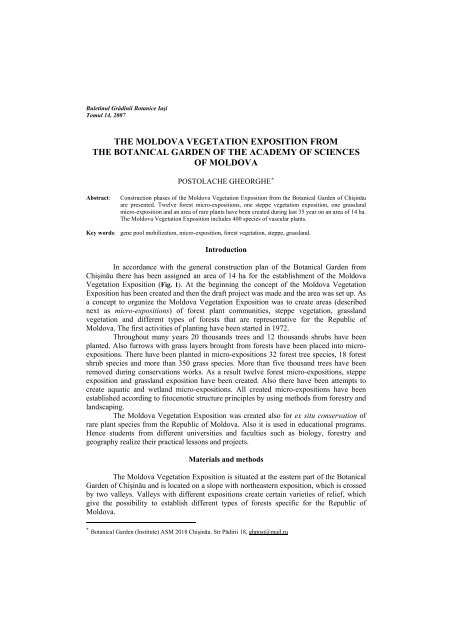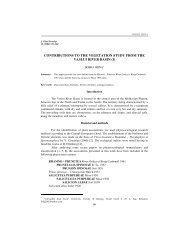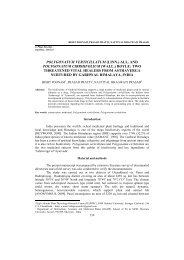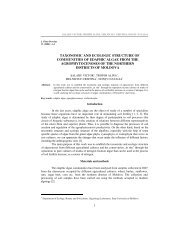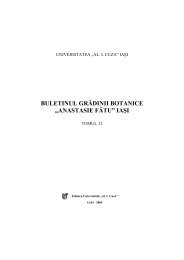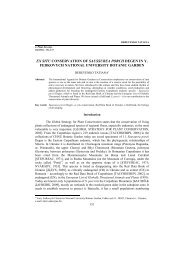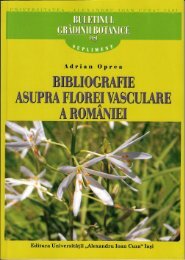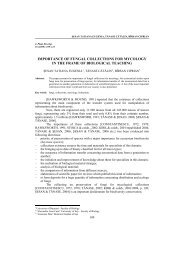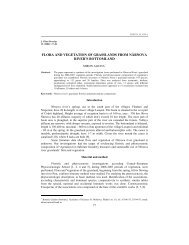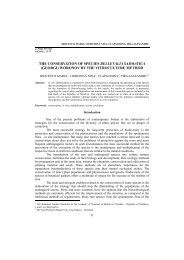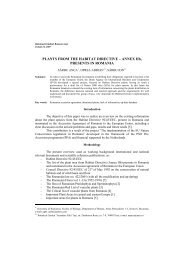the moldova vegetation exposition from - Journal of Plant ...
the moldova vegetation exposition from - Journal of Plant ...
the moldova vegetation exposition from - Journal of Plant ...
Create successful ePaper yourself
Turn your PDF publications into a flip-book with our unique Google optimized e-Paper software.
Buletinul Grădinii Botanice Iaşi<br />
Tomul 14, 2007<br />
THE MOLDOVA VEGETATION EXPOSITION FROM<br />
THE BOTANICAL GARDEN OF THE ACADEMY OF SCIENCES<br />
OF MOLDOVA<br />
POSTOLACHE GHEORGHE ∗<br />
Abstract:<br />
Construction phases <strong>of</strong> <strong>the</strong> Moldova Vegetation Exposition <strong>from</strong> <strong>the</strong> Botanical Garden <strong>of</strong> Chişinău<br />
are presented. Twelve forest micro-<strong>exposition</strong>s, one steppe <strong>vegetation</strong> <strong>exposition</strong>, one grassland<br />
micro-<strong>exposition</strong> and an area <strong>of</strong> rare plants have been created during last 35 year on an area <strong>of</strong> 14 ha.<br />
The Moldova Vegetation Exposition includes 400 species <strong>of</strong> vascular plants.<br />
Key words: gene pool mobilization, micro-<strong>exposition</strong>, forest <strong>vegetation</strong>, steppe, grassland.<br />
Introduction<br />
In accordance with <strong>the</strong> general construction plan <strong>of</strong> <strong>the</strong> Botanical Garden <strong>from</strong><br />
Chişinău <strong>the</strong>re has been assigned an area <strong>of</strong> 14 ha for <strong>the</strong> establishment <strong>of</strong> <strong>the</strong> Moldova<br />
Vegetation Exposition (Fig. 1). At <strong>the</strong> beginning <strong>the</strong> concept <strong>of</strong> <strong>the</strong> Moldova Vegetation<br />
Exposition has been created and <strong>the</strong>n <strong>the</strong> draft project was made and <strong>the</strong> area was set up. As<br />
a concept to organize <strong>the</strong> Moldova Vegetation Exposition was to create areas (described<br />
next as micro-<strong>exposition</strong>s) <strong>of</strong> forest plant communities, steppe <strong>vegetation</strong>, grassland<br />
<strong>vegetation</strong> and different types <strong>of</strong> forests that are representative for <strong>the</strong> Republic <strong>of</strong><br />
Moldova. The first activities <strong>of</strong> planting have been started in 1972.<br />
Throughout many years 20 thousands trees and 12 thousands shrubs have been<br />
planted. Also furrows with grass layers brought <strong>from</strong> forests have been placed into micro<strong>exposition</strong>s.<br />
There have been planted in micro-<strong>exposition</strong>s 32 forest tree species, 18 forest<br />
shrub species and more than 350 grass species. More than five thousand trees have been<br />
removed during conservations works. As a result twelve forest micro-<strong>exposition</strong>s, steppe<br />
<strong>exposition</strong> and grassland <strong>exposition</strong> have been created. Also <strong>the</strong>re have been attempts to<br />
create aquatic and wetland micro-<strong>exposition</strong>s. All created micro-<strong>exposition</strong>s have been<br />
established according to fitocenotic structure principles by using methods <strong>from</strong> forestry and<br />
landscaping.<br />
The Moldova Vegetation Exposition was created also for ex situ conservation <strong>of</strong><br />
rare plant species <strong>from</strong> <strong>the</strong> Republic <strong>of</strong> Moldova. Also it is used in educational programs.<br />
Hence students <strong>from</strong> different universities and faculties such as biology, forestry and<br />
geography realize <strong>the</strong>ir practical lessons and projects.<br />
Materials and methods<br />
The Moldova Vegetation Exposition is situated at <strong>the</strong> eastern part <strong>of</strong> <strong>the</strong> Botanical<br />
Garden <strong>of</strong> Chişinău and is located on a slope with nor<strong>the</strong>astern <strong>exposition</strong>, which is crossed<br />
by two valleys. Valleys with different <strong>exposition</strong>s create certain varieties <strong>of</strong> relief, which<br />
give <strong>the</strong> possibility to establish different types <strong>of</strong> forests specific for <strong>the</strong> Republic <strong>of</strong><br />
Moldova.<br />
∗<br />
Botanical Garden (Institute) ASM 2018 Chişinău. Str Pădirii 18, ghpost@mail.ru
122<br />
It was conceive to establish main forest types such as: beech forests (Fagus<br />
sylvatica), sessile oak forests (Quercus petraea), pedunculate oak forests (Quercus robur),<br />
pubescent oak forests (Quercus pubescens), white poplar forests (Populus alba) and willow<br />
forests (Salix alba, Salix fragilis).<br />
The trees and shrubs have been planted irregularly but with <strong>the</strong> endeavor that <strong>the</strong><br />
composition would be more close to <strong>the</strong> structure <strong>of</strong> natural forests. Trees and shrubs have<br />
been transported <strong>from</strong> each type <strong>of</strong> natural forests and were planted in each type <strong>of</strong> micro<strong>exposition</strong>.<br />
The grass layer has been made by transplanting furrows with grass layers<br />
(30x30 cm) brought <strong>from</strong> natural forests that have been placed in micro-<strong>exposition</strong>s.<br />
Cleaning and conservation cuttings have been carried out each five years.<br />
The steppe micro-<strong>exposition</strong> has been created by using next two methods: <strong>the</strong><br />
method <strong>of</strong> furrows with grass layer and <strong>the</strong> second method by sowing seeds previously<br />
collected. The seeds <strong>of</strong> next species have been collected (Stipa capilata, S lesingiana,S.<br />
pulcherima, Festuca valesiaca etc.) <strong>from</strong> <strong>the</strong> Bujac steppe. These methods have been also<br />
used to realize areas with grass <strong>vegetation</strong> in St.Petesburg (Tanfiliev,1901), Moscow<br />
(Sorokina, 1960), Stavropol (Skripcinski, 1973; Dudari,1977; Dzăbov 1977), Doneţk<br />
(Ziman, Ivaşin,Ciuprina,1975), Chişinău (Postolache, 1984,2004). Works <strong>of</strong> creation <strong>the</strong><br />
Moldova Vegetation Exposition commence in 1972 and continue in present time.<br />
Results and discussions<br />
Moldova forests and establishment <strong>of</strong> forests micro-<strong>exposition</strong>s<br />
The spontaneous forests in Moldova consist <strong>of</strong> broadleaved formations <strong>of</strong> Central<br />
Europe type. The main components in <strong>the</strong> forest formations are <strong>the</strong> pedunculate oak<br />
(Quercus robur), <strong>the</strong> sessile oak (Quercus petraea), <strong>the</strong> pubescent oak (Quercus pubescens)<br />
and <strong>the</strong> beech (Fagus sylvatica). Their spread on <strong>the</strong> territory <strong>of</strong> <strong>the</strong> Republic <strong>of</strong> Moldova<br />
depends on <strong>the</strong> hypsometric levels, on <strong>the</strong> <strong>exposition</strong> and <strong>the</strong> degree <strong>of</strong> slope inclination, on<br />
<strong>the</strong> soil and o<strong>the</strong>r conditions [1, 2, 3]. These and o<strong>the</strong>r factors determined <strong>the</strong> formation <strong>of</strong><br />
different types <strong>of</strong> forests and associations.<br />
The pedunculate oak is <strong>the</strong> principal species in <strong>the</strong> forest stands <strong>from</strong> <strong>the</strong> nor<strong>the</strong>rn<br />
zone. Ninety percent <strong>of</strong> natural forests in <strong>the</strong> nor<strong>the</strong>rn part <strong>of</strong> Moldova belong to <strong>the</strong> forest<br />
type “forest oak with cherry” (Prunus avium).<br />
The Central Zone <strong>of</strong> <strong>the</strong> Republic <strong>of</strong> Moldova is a more compact forest massif and<br />
is comparable to <strong>the</strong> broadleaf forest <strong>of</strong> <strong>the</strong> central zone <strong>of</strong> Europe. The dominant tree<br />
species are Fagus sylvatica, Quercus petraea and Quercus robur. The favourable<br />
ecological conditions lead to <strong>the</strong> formation <strong>of</strong> highly productive forest stands. Hornbeam<br />
(Carpinus betulus) is abundant in forest stands.<br />
The Sou<strong>the</strong>rn Zone is <strong>the</strong> driest, and is characterized by oak at <strong>the</strong> higher<br />
elevations and by pedunculate oak mixed with blackthorn at lower elevations. Fluffy oak<br />
forests (Quercus pubescens) are found on south and south-western slopes at lower<br />
elevations.<br />
The territory <strong>of</strong> <strong>the</strong> Botanical Garden allocated for <strong>the</strong> establishment <strong>of</strong> <strong>the</strong><br />
Moldova Vegetation Exposition includes plateau and hills with different <strong>exposition</strong>s,<br />
variety <strong>of</strong> soil types and hydrological conditions. The presence <strong>of</strong> a variety <strong>of</strong> conditions at<br />
<strong>the</strong> Botanical Garden permitted establishment <strong>of</strong> major types <strong>of</strong> forests that have been<br />
carried out by taking into considerations local conditions.
123<br />
Beech micro-<strong>exposition</strong><br />
Beech forests (Fagus sylvatica) are spread only in northwestern part <strong>of</strong> Codrii<br />
Reserve <strong>from</strong> Central part <strong>of</strong> Moldova. Beech in Moldova is situated at <strong>the</strong> eastern border<br />
<strong>of</strong> <strong>the</strong> distribution area. Besides beech o<strong>the</strong>r tree species are scatter distributed such as:<br />
Tilia cordata, T. tomentosa, Acer pseudoplatanus, Acer platanoides. Hornbeam (Carpinus<br />
betulus) dominates <strong>the</strong> second tree layer in beech forests.<br />
In order to establish beech micro-<strong>exposition</strong> an area <strong>of</strong> 0,54ha have been allocated, on a hill<br />
with northwestern <strong>exposition</strong>, 6-8 degrees slope inclination and with sandy-clay soil.<br />
The area had been ploughed and prepared for planting works. There have been<br />
brought 1050 beech trees (3-4 years old) <strong>from</strong> Codrii Reserve and Sadova forest. Scattered<br />
accompanying forest species have been planted, during <strong>the</strong> period <strong>of</strong> 1976-1978, such as<br />
Quercus petraea, Tilia tomentosa, Acer pseudoplatanus, Acer platanoides. Also solitary<br />
exemplars <strong>of</strong> Viburnum lantana, Swida sanguinea and Cornus mass have been planted.<br />
Simultaneously with brought planted materials have been transported herb species such as<br />
Polygonatum latifolia, Carex brevicollis, C. pilosa, Epipactis heleborine and Allium<br />
ursinum.<br />
Nowadays in beech micro-<strong>exposition</strong> <strong>the</strong>re could be identified next plant species<br />
Anemonoides ranunculoides, Isopyrum thalictroides, Tulipa bibersteinana,, Scopolia<br />
carniolica, Glechoma hirsuta, Hedera helix, Viola reichenbachiana. Next tree species are<br />
present also: Carpinus betulus, Acer platanoides, Acer pseudoplatanus, Quercus petraea,<br />
Tilia cordata, Fraxinus excelsior, Acer campestre, Morus nigra, Cerasus avium, Tilia<br />
tomentosa. The cover degree <strong>of</strong> grassy layer constitutes 5%. Crown cover is 0,9 and beech<br />
trees reach 15 meters height.<br />
Sessile oak micro-<strong>exposition</strong><br />
Sessile oak forests are dominant in <strong>the</strong> Central part <strong>of</strong> Moldova and are spread on<br />
an area <strong>of</strong> 56,5 thousands ha. In sessile oak forests are present next tree species: hornbeam<br />
(Carpinus betulus), white lime (Tilia tomentosa), ash tree (Fraxinus excelsior), cherry<br />
(Cerasus avium), sycamore (Acer pseudoplatanus), norway maple (Acer platanoides) and<br />
wild service tree (Sorbus torminalis).<br />
Four different sessile oak micro-<strong>exposition</strong>s have been created in <strong>the</strong> Botanical<br />
Garden <strong>of</strong> Chişinău: sessile oak with beech tree, sessile oak with smoke tree (Cotinus<br />
coggygria), sessile oak with lime and common ash (Fraxinus excelsior) and sessile oak<br />
with hornbeam.<br />
The sessile oak with beech tree micro-<strong>exposition</strong> was established in 1975 on two<br />
slopes with different <strong>exposition</strong>s. At <strong>the</strong> beginning only beech trees have been introduced<br />
and after next tree species have been planted: Carpinus betulus, Fraxinus excelsior, Acer<br />
pseudoplatanus, Acer platanoides, Quercus petraea, Tilia tomentosa, T.cordata, Cerasus<br />
avium, Acer campestre, Malus sylvestris, Pyrus pyraster and Sorbus torminalis.<br />
Bush species such as Swida sanguinea, Crataegus monogyna, Euonymus europaea,<br />
Euonymus verrucosa, Cornus mass and Viburnum lantana have been planted in 1978.<br />
Next plant species are present in sessile oak with beech tree micro-<strong>exposition</strong>:<br />
Carex brevicollis, C.pilosa, Convalaria majalis, Scilla bifolia, Corydalis solida, Isopyrum<br />
thalictroides, Vinca minor, Viola ambigua, Geum urbanum, Chelidonium majus, Ballota<br />
nigra, Hedera helix.<br />
Pedunculate oak micro-<strong>exposition</strong><br />
The pedunculate oak is <strong>the</strong> principal species in <strong>the</strong> forest stands <strong>from</strong> nor<strong>the</strong>rn<br />
zone. Ninety percent <strong>of</strong> natural forests in <strong>the</strong> nor<strong>the</strong>rn part <strong>of</strong> Moldova belong to <strong>the</strong> forest
124<br />
type “forest oak with cherry” (Prunus avium). Pedunculate oak with hornbeam forests type<br />
are spread in <strong>the</strong> central part <strong>of</strong> Moldova and pedunculate oak with fluffy oak forests type<br />
are situated in <strong>the</strong> sou<strong>the</strong>rn part <strong>of</strong> Moldova.<br />
The micro-<strong>exposition</strong> <strong>of</strong> pedunculate oak with hornbeam was established in<br />
1972. At <strong>the</strong> beginning seedling <strong>of</strong> pedunculate oak <strong>of</strong> two years old have been planted and<br />
after in 1975 next forest tree species have been planted: Tilia cordata, T.tomentosa,<br />
Fraxinus excelsior, Acer platanoides, Acer pseudoplatanus, Cerasus avium, Populus<br />
tremula, Acer campestre, Malus sylvestris, Pyrus pyraster and also some bushy species<br />
have been introduced, such as Swida sanguinea, Crataegus monogyna, Viburnum lantana,<br />
Euonymus verucosa, Ligustrum vulgare and Euonymus europaea.<br />
Currently in <strong>the</strong> micro-<strong>exposition</strong> <strong>of</strong> pedunculate oak with hornbeam are present<br />
15 tree species, 11 bushy species and approximately 37 plant species, among which next<br />
species are typical for pedunculate oak with hornbeam forest type (Quercus robur,<br />
Carpinus betulus, Tilia cordata, Acer campestre, Ficaria verna, Tulipa bibersteiniana,<br />
Carex brevicollis, C.pilosa).<br />
The micro-<strong>exposition</strong> <strong>of</strong> pedunculate oak with cherry was established in 1972 on<br />
an area <strong>of</strong> 1,1 ha and on a slope with nor<strong>the</strong>rn <strong>exposition</strong>. Ground water is at <strong>the</strong> depth <strong>of</strong><br />
13m on <strong>the</strong> top <strong>of</strong> <strong>the</strong> slope and at <strong>the</strong> depth <strong>of</strong> 5m at <strong>the</strong> bottom <strong>of</strong> slope. Grey forest soil<br />
with different depth is present.<br />
At <strong>the</strong> beginning Cerasus avium, Rhamnus tinctoria, Frangula alnus have been<br />
carried <strong>from</strong> nor<strong>the</strong>rn part <strong>of</strong> Moldova and planted. During <strong>the</strong> period 1975-1982 next tree<br />
species and bushy species have been planted: Acer platanoides, Acer pseudoplatanus, Acer<br />
campestre, Acer tataricum, Swida sanguinea, Crataegus monogyna, Viburnum lantana.<br />
At present time next vascular plant species are spread in <strong>the</strong> micro-<strong>exposition</strong> <strong>of</strong><br />
pedunculate oak with cherry: Pulmonaria mollis, Veratrum nigrum, Vinca minor, Lilium<br />
martagon, Fritilaria meleagroides, Poa nemoralis, Galium molugo, Cephalan<strong>the</strong>ra<br />
longifolia, Dentaria bulbifera, Corydalis solida, Corydalis cava, Anemonoides<br />
ranunculoides, Anemonoides nemorosa, Galeobdolon luteum, Glechoma hirsuta, Arum<br />
orientale, Allium ursinum, Ranunculus auricomus, Gagea lutea, Adoxa moshatelina,<br />
Ficaria verna, Galium apparine, Galium odoratum, Nectaroscordum dioscoridis,<br />
Geranium phaeum, Stellaria holostea, Isopyrum thalictroides, Asarum europaeum,<br />
Polygonatum latifolium, Polygonatum multiflorum, Polystychum aculeatum, Galanthus<br />
nivalis, Lunaria annua.<br />
As <strong>the</strong> result <strong>of</strong> carried work plantation, currently in <strong>the</strong> micro-<strong>exposition</strong> <strong>of</strong><br />
pedunculate oak with cherry are present 9 forest tree species, 5 bushy species and 33 plant<br />
species, among which next species (Quercus robur, Cerasus avium, Rhamnus tinctoria,<br />
Frangula alnus, Veratrum nigrum, Pulmonaria mollis) are characteristic for pedunculate<br />
oak with cherry forest type. A remarkable oak tree <strong>of</strong> 30 years old reaches 20m height and<br />
50cm in diameter. Oak trees produced seeds in <strong>the</strong> year 2000 and plantlets have been<br />
observed in 2001.
125<br />
Fig. 1 Scheme <strong>of</strong> Moldova Vegetation Exposition<br />
Conclusions<br />
In <strong>the</strong> Botanical Garden <strong>from</strong> Chişinău has been established during last 35 years<br />
<strong>the</strong> “Moldova Vegetation Exposition” that includes 12 forest micro-<strong>exposition</strong>s, steppe<br />
micro-<strong>exposition</strong>, grassland micro-<strong>exposition</strong> and a sector with rare plant species. 400<br />
vascular plants species are <strong>the</strong> gen<strong>of</strong>ond <strong>of</strong> Moldova Vegetation Exposition.<br />
References<br />
1. ПАЧОСКИЙ И.К., 1914 – Очерк растительности Бессарабии. Кишинев.<br />
2. ГЕЙДЕМАН Т.С., ОСТАПЕНКО Б.Ф.,НИКОЛАЕВА Л.П и др., 1964 – Типы леса и лесные<br />
ассоциации Молдавской ССР. Кишинев «Картеа Молдовенеаскэ».<br />
3. POSTOLACHE GH., 1995 – Vegetaţia Republicii Moldova. Chişinău: 340pp.


